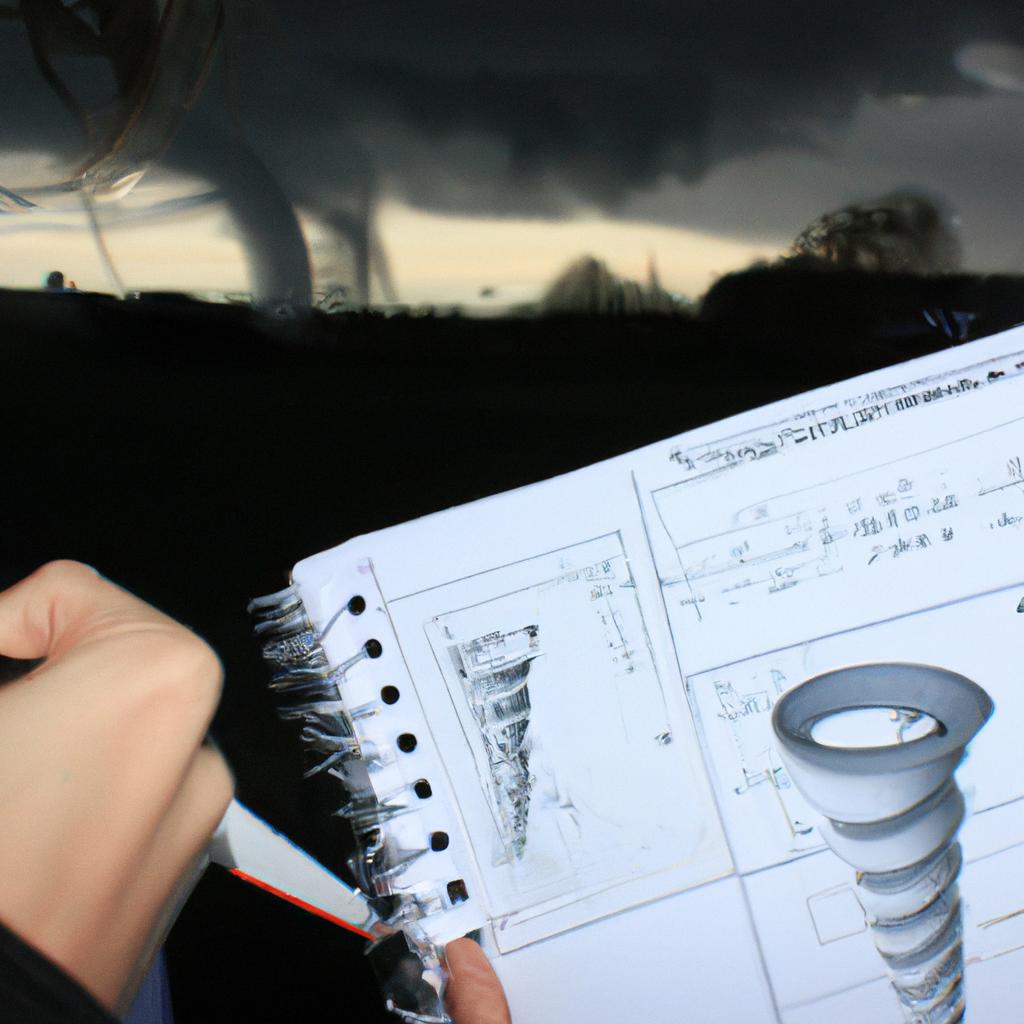Droughts, as extreme weather events, have been a persistent concern in the context of climate change. The depletion of water resources and prolonged periods of inadequate rainfall pose significant challenges to ecosystems, agriculture, and human livelihoods worldwide. To illustrate this issue, consider the case study of California’s recent drought from 2012 to 2017. This severe drought had far-reaching consequences on various sectors, including agriculture, energy production, and water supply management.
In recent years, there has been growing recognition that climate change exacerbates drought conditions through its impact on precipitation patterns and evaporation rates. Climate models predict an increase in the frequency and severity of drought events globally due to rising temperatures and altered atmospheric circulation patterns. These changes disrupt regional climates and lead to shifts in precipitation distribution, resulting in more frequent dry spells and extended periods without adequate rainfall. Understanding the complex relationship between droughts and climate change is crucial for developing effective mitigation strategies and adaptation measures to minimize their detrimental effects on both natural systems and human societies.
Understanding Droughts and Climate Change
Droughts are one of the most significant natural disasters that affect numerous regions worldwide. As climate change continues to alter weather patterns, it is crucial to comprehensively understand the relationship between droughts and this global phenomenon. To illustrate the implications of these extreme events, let us consider a hypothetical scenario where a region experiences a prolonged period of below-average rainfall resulting in severe agricultural losses, reduced water availability for households, increased wildfire risks, and socio-economic ramifications.
The impact of droughts extends beyond immediate consequences such as crop failure or limited access to clean drinking water. It affects various aspects of society, including human health, ecosystem stability, and economic productivity. To grasp the complexity of this issue further, we can examine several key points:
- Economic Implications: Reduced agricultural output leads to higher food prices and potential job losses in farming communities.
- Environmental Consequences: Droughts disrupt ecosystems by reducing plant growth rates, increasing vulnerability to pests and diseases, and causing habitat loss for wildlife.
- Social Challenges: Water scarcity strains societal well-being through conflicts over resource allocation and compromised hygiene practices.
- Health Risks: Limited water supplies contribute to inadequate sanitation facilities, which gives rise to an increased risk of infectious diseases.
To better visualize the interconnectedness of these factors within the context of droughts and climate change, the following table highlights their respective impacts on different sectors:
| Sectors | Economic Impact | Environmental Consequence | Social Challenge |
|---|---|---|---|
| Agriculture | Higher food prices | Reduced plant growth | Conflicts over resource |
| allocation | |||
| Ecosystem | Job losses | Increased vulnerability to pests | Compromised hygiene |
| and diseases | practices | ||
| Health | 0 Inadequate sanitation | ||
| facilities |
Understanding the intricate relationship between droughts and climate change is crucial for formulating effective mitigation strategies. By examining the economic, environmental, social, and health impacts of these extreme events, we can gain insight into their complex nature. In the subsequent section on “Causes of Droughts,” we will explore the underlying factors contributing to this growing problem in more detail.
Causes of Droughts
Droughts are among the most devastating natural disasters that have severe impacts on human societies, ecosystems, and economies. In recent years, there has been growing concern about the link between droughts and climate change. Extensive research conducted worldwide suggests a strong correlation between these two phenomena, indicating that climate change is exacerbating the frequency and intensity of drought events.
To illustrate this point, let us consider a hypothetical scenario in which a region experiences an extended period of below-average rainfall for several consecutive years. The lack of precipitation leads to decreased soil moisture content, resulting in reduced agricultural productivity and water scarcity for both domestic and industrial use. As a consequence, farmers struggle to maintain their livelihoods, communities face food shortages, and industries suffer financial losses.
The relationship between droughts and climate change can be further understood through various key factors:
- Increased temperatures: Rising global temperatures enhance evaporation rates from land surfaces and bodies of water. This increased evapotranspiration intensifies dry conditions by depleting available moisture.
- Changes in atmospheric circulation patterns: Alterations in weather systems caused by climate change result in shifts in rainfall distribution. Some regions may experience prolonged dry spells while others receive excessive rainfall within shorter periods.
- Melting glaciers: Glacial retreat due to rising temperatures reduces freshwater availability during drier seasons when meltwater runoff usually replenishes rivers and lakes.
- Oceanic influences: Changes in sea surface temperature patterns influence regional climates, leading to alterations in precipitation patterns over adjacent land areas.
Table 1 highlights some alarming statistics regarding the consequences of droughts on different sectors:
| Sector | Impacts |
|---|---|
| Agriculture | Crop failures; livestock deaths; reduced yields |
| Water Resources | Depletion of reservoirs; groundwater contamination |
| Economy | Losses in revenue; decreased employment opportunities |
| Public Health | Increased risk of waterborne diseases; malnutrition |
Despite the undeniable link between droughts and climate change, it is important to note that other factors such as land-use changes and poor water management practices can also exacerbate their impacts. These findings underscore the urgency for adopting sustainable strategies in managing water resources, implementing resilient agricultural practices, and reducing greenhouse gas emissions.
Transitioning into the subsequent section about “Impacts of Droughts on Ecosystems,” it becomes evident that understanding the ecological consequences of these extreme weather events is crucial in developing effective adaptation and mitigation strategies.
Impacts of Droughts on Ecosystems
As droughts become more frequent and severe due to climate change, their impacts on ecosystems are becoming increasingly significant. These prolonged periods of water scarcity can disrupt the delicate balance within natural systems, affecting various aspects of ecosystem health and functionality. Understanding these impacts is crucial for developing effective strategies to mitigate the consequences of drought events. This section will explore some of the key ways in which ecosystems are affected by droughts.
Destruction of Habitat:
One notable impact of droughts on ecosystems is the destruction of habitat for numerous plant and animal species. As water availability decreases, wetlands, rivers, and lakes may dry up completely or shrink significantly. For instance, consider the hypothetical case study scenario where a severe drought strikes a coastal region that supports diverse marine life. With dwindling water levels, estuaries and salt marshes would suffer from reduced freshwater inflow, disrupting vital breeding grounds for fish and other aquatic organisms.
Reduced Biodiversity:
The loss or degradation of habitat during drought events often leads to a decline in biodiversity within affected ecosystems. Many flora and fauna species have specific moisture requirements that cannot be met during extended dry spells. Consequently, certain plants may die off due to lack of water, while others may struggle to reproduce successfully without adequate moisture conditions. The disruption caused by droughts can result in reduced species richness and altered community dynamics within ecosystems.
Economic Consequences:
In addition to ecological disruptions, droughts also have profound economic consequences linked to ecosystem services provided by healthy natural systems. When habitats are destroyed or biodiversity is negatively impacted, essential services such as pollination, soil fertility maintenance, pest control, and nutrient cycling can be compromised. This depletion affects agricultural productivity, leading to decreased crop yields and potential food shortages in regions heavily reliant on farming.
- Loss of iconic landscapes cherished by communities
- Threatened livelihoods of farmers and agricultural workers
- Increased vulnerability of endangered species to extinction
- Potential disruption of recreational activities like fishing or birdwatching
Emotional Response Table:
| Impacts | Magnitude | Consequences |
|---|---|---|
| Destruction of Habitat | High | Loss of breeding grounds for aquatic organisms |
| Reduced Biodiversity | Moderate | Decline in plant and animal populations |
| Economic Consequences | Significant | Decreased crop yields and potential food shortages |
The impacts outlined above demonstrate the far-reaching consequences that droughts can have on ecosystems. However, it is equally important to recognize how these events affect human societies. The subsequent section will delve into the topic of human impacts and vulnerability to droughts, examining both social and economic aspects alongside environmental concerns.
Human Impacts and Vulnerability to Droughts
A case study in the Amazon rainforest provides a vivid example of the far-reaching impacts that droughts can have on ecosystems. During an extreme drought in 2005, rivers and streams in the region dried up, causing water levels to significantly decrease. As a result, numerous fish species were unable to survive due to lack of habitat and decreased food availability. This disruption in the aquatic ecosystem had ripple effects throughout the food chain, ultimately leading to declines in bird populations that rely on fish as their primary food source.
Droughts not only affect individual species but also alter entire ecosystems. The absence or scarcity of water leads to changes in vegetation patterns, with some plant species being more resilient than others. Consequently, competition for limited resources intensifies among plants, potentially resulting in shifts in biodiversity and overall composition of plant communities. These alterations can further impact other organisms dependent on specific plant species for shelter or sustenance.
The implications of drought extend beyond ecological consequences; they also pose significant challenges to human societies. Consider the following bullet points illustrating how droughts affect people emotionally:
- Increased anxiety and stress due to uncertain access to water.
- Economic hardships caused by crop failure and livestock losses.
- Displacement and migration as individuals seek better living conditions.
- Loss of cultural heritage tied to traditional practices reliant on water resources.
To highlight these emotional aspects further, a table showcasing the psychological impacts associated with drought events is presented below:
| Psychological Impacts | Examples |
|---|---|
| Depression | Feelings of hopelessness and worthlessness |
| Anxiety | Worry about future uncertainties |
| Insomnia | Sleep disturbances due to stress |
| Post-Traumatic Stress Disorder (PTSD) | Trauma-related symptoms after experiencing severe drought |
As we delve deeper into understanding the multifaceted repercussions of drought events, it becomes evident that mitigation strategies are crucial. Transitioning into the subsequent section on “Mitigation Strategies for Droughts”, it is imperative to explore proactive approaches aimed at minimizing the adverse effects of droughts and fostering resilience in both ecosystems and human communities.
Mitigation Strategies for Droughts
Droughts have severe impacts on human societies, causing economic losses, food shortages, and water scarcity. These extreme weather events are exacerbated by climate change, leading to increased frequency and intensity. Understanding the vulnerability of communities to drought is crucial for implementing effective adaptation strategies. This section explores the various ways in which humans are affected by droughts and highlights their vulnerabilities.
One example that illustrates the human impacts of drought is the prolonged dry spell experienced in California from 2012 to 2017. The state faced a significant reduction in rainfall, resulting in widespread water shortages and agricultural losses. Farmers struggled to irrigate their crops, leading to decreased yields and financial hardship. Additionally, many residents had limited access to clean drinking water, forcing them to rely on rationing measures or alternative sources.
The vulnerability of communities to drought can be attributed to several factors:
- Socioeconomic status: Low-income populations often lack the resources needed to cope with prolonged periods of drought. They may face difficulties affording necessary adaptations such as installing efficient irrigation systems or purchasing supplemental water supplies.
- Geographic location: Regions already prone to aridity or areas dependent on specific water sources are particularly vulnerable when faced with drought conditions.
- Infrastructure development: Inadequate infrastructure systems can exacerbate the impacts of droughts. For instance, outdated water distribution networks may lead to further loss due to leakage or inefficient supply management during times of scarce water resources.
- Dependency on agriculture: Communities heavily reliant on agriculture are susceptible to severe economic losses during droughts as crop failures occur more frequently.
To highlight the gravity of these vulnerabilities, consider the following table illustrating selected statistics related to human impacts caused by recent major drought events around the world:
| Country | Year | Economic Loss (USD) | Number of People Affected |
|---|---|---|---|
| Somalia | 2011 | $2.4 billion | 13 million |
| Australia | 2006-07 | $5.7 billion | Over 60,000 |
| India | 1999 | $10.3 billion | Around 330 million |
| Brazil | 2010-12 | $14.8 billion | Over 20 million |
These figures highlight the significant economic and humanitarian costs associated with droughts, underscoring the urgent need for effective mitigation strategies.
In light of the vulnerabilities discussed, it is essential to explore adaptation measures that can minimize the effects of droughts on human societies. The subsequent section will delve into various strategies implemented at both local and national levels to enhance resilience and mitigate damages caused by these extreme weather events.
Adaptation Measures to Minimize Drought Effects
Droughts have become increasingly frequent and severe in recent years due to the impacts of climate change. As a result, it is crucial to implement effective mitigation strategies that can help minimize the occurrence and intensity of drought events. By taking proactive measures, we can reduce the vulnerability of communities and ecosystems to these extreme weather events.
One example of a successful mitigation strategy is the implementation of water conservation practices in agriculture. In regions experiencing chronic water scarcity, farmers have adopted various techniques to optimize their water usage. These include precision irrigation systems that deliver water directly to plant roots, as well as improved soil management practices such as mulching and cover cropping. Through these methods, farmers can maximize crop productivity while minimizing water consumption.
To further address the challenges posed by droughts, governments and organizations are investing in research and development to promote technological innovations. For instance, remote sensing technologies combined with advanced modeling techniques enable scientists to monitor soil moisture levels across vast areas in real-time. This information helps inform decision-making processes related to land use planning, agricultural practices, and water resource management.
In addition to these concrete actions, fostering community engagement and raising awareness about sustainable water management practices are essential components of mitigating drought impacts. By promoting behavior changes at an individual level, such as reducing personal water consumption or implementing rainwater harvesting systems at home, we can collectively contribute towards building more resilient communities.
- Increased investment in research and development for innovative solutions.
- Encouragement of sustainable farming practices through incentives.
- Implementation of stricter regulations on industrial water usage.
- Promotion of public awareness campaigns on responsible water consumption.
Markdown table:
| Mitigation Strategy | Benefits |
|---|---|
| Water conservation practices in agriculture | Reduces strain on limited freshwater resources |
| Technological advancements (remote sensing) | Enables efficient monitoring and data-driven decision making |
| Community engagement | Fosters a sense of collective responsibility and increases resilience |
| Policy measures and regulations | Ensures accountability and promotes sustainable water management |
In conclusion, mitigating the impacts of droughts requires a multi-faceted approach that incorporates technological advancements, policy changes, and community engagement. By implementing effective strategies such as water conservation practices in agriculture, investing in research and development, raising awareness about responsible water usage, and enforcing stricter regulations on industrial water consumption, we can work towards minimizing the occurrence and severity of drought events. Together, these efforts will contribute to building more resilient communities and ecosystems in the face of climate change challenges.




